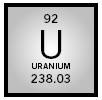Uranium

MELTING POINT:
1,408°C
BOILING POINT:
4,404°C
DENSITY:
19.04 g/cm
3
MOST COMMON IONS:
U
3+
, U
4+
, UO
2
+
, UO
2
2+
Uranium is a very dense, highly reactive, metallic element that has the highest atomic mass of the naturally occurring elements. Natural uranium consists of two long-lived radioactive isotopes : 238 U (99.28%) and 235 U (0.72%). A very small amount of 234 U (0.005%) occurs in secular equilibrium with 238 U. Uranium was discovered in 1789 by Martin Klaproth, who named it after the planet Uranus (which had just been discovered). In 1841 Eugène Melchior Péligot prepared uranium metal and proved that Klaproth had actually isolated uranium dioxide.
Uranium is found in Earth's crust at an average concentration of about 2 ppm, and is more abundant than silver or mercury. The most common uranium-containing mineral is uraninite, a complex uranium oxide. Other uranium-containing minerals are autunite, a hydrated calcium uranium phosphate, and carnotite, a hydrated potassium uranium vanadate.
The most prevalent form of uranium in aqueous solution is the light yellow, fluorescent uranyl ion UO 2 2+ . The U 4+ cation (green in solution) can be obtained by strong reduction of U(VI), but readily oxidizes back to UO 2 2+ in air. The pentavalent ion UO 2 + can be reversibly formed by reduction of UO 2 2+ , but it readily disproportionates into U(IV) and U(VI). The trivalent U 3+ can be formed by reduction of U(IV) but is unstable to oxidation in aqueous solution.
After the discovery of uranium radioactivity by Henri Becquerel in 1896, uranium ores were used primarily as a source of radioactive decay products such as 226 Ra. With the discovery of nuclear fission by Otto Hahn and Fritz Strassman in 1938, uranium became extremely important as a source of nuclear energy. Hahn and Strassman made the experimental discovery; Lise Meitner and Otto Frisch provided the theoretical explanation. Enrichment of the spontaneous fissioning isotope 235 U in uranium targets led to the development of the atomic bomb, and subsequently to the production of nuclear-generated electrical power. There are considerable amounts of uranium in nuclear waste throughout the world.
SEE ALSO Actinium ; Berkelium ; Einsteinium ; Fermium ; Lawrencium ; Mendelevium ; Neptunium ; Nobelium ; Plutonium ; Protactinium ; Rutherfordium ; Thorium .
W. Frank Kinard
Bibliography
Katz, Joseph J.; Seaborg, Glenn T.; and Morss, Lester T. (1986). The Chemistry of the Actinide Elements, 2nd edition. New York: Chapman and Hall.
Lide, David R., ed. (1995–1996). The CRC Handbook of Chemistry and Physics, 76th edition. Boca Raton, FL: CRC Press.
Comment about this article, ask questions, or add new information about this topic: